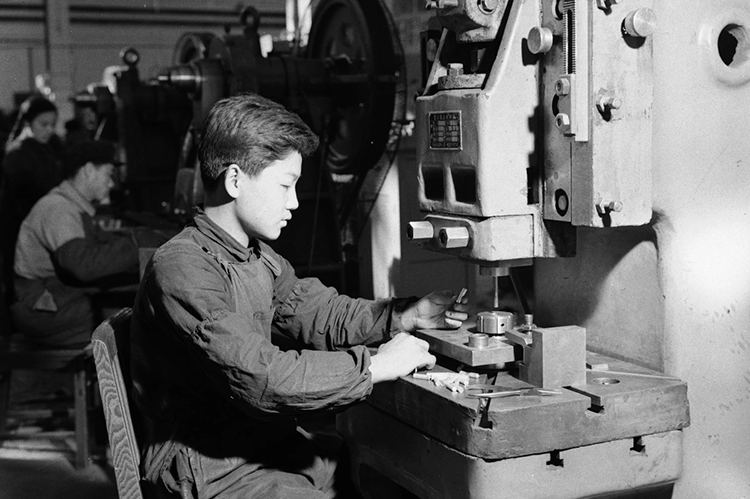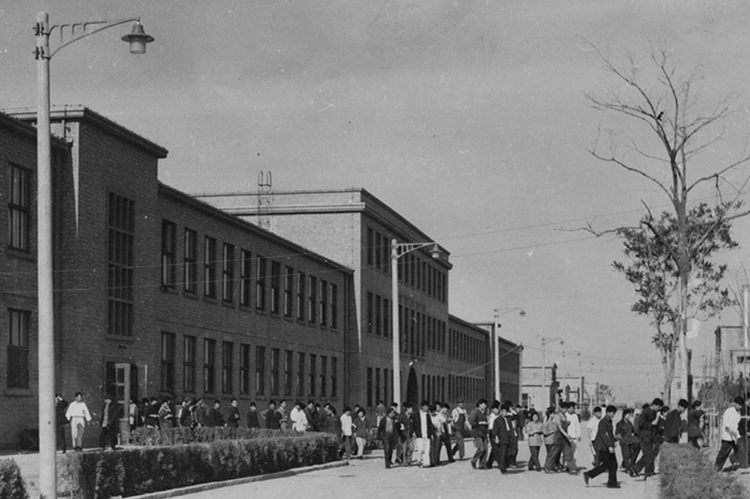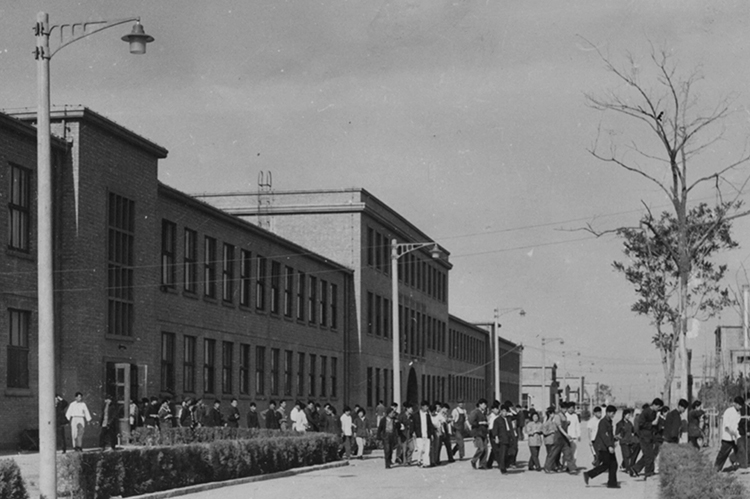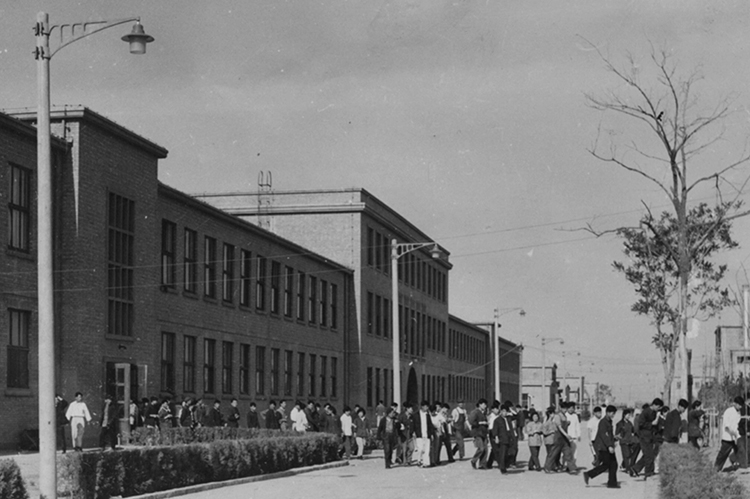

718:一个不应被忽略的现代设计历史节点
718:A Joint in Modern Design History that Cannot be Ignored
国际对接
718厂的总体化建设方式实现了一次对于中国工业化进程极为重要的国际对接。
50年代的世界由意识形态对峙而分为东西两大阵营,欧美国家掌握着较为先进的工业生产技术但系统分散,以前苏联为首的社会主义阵营技术相对滞后但资源高度集中,重点顾及国家政权稳固但研发投入不足。西方国家出于策略需要对中国等东方国家实行技术封锁,刚刚摆脱多年战火、急需走向和平建设的中国,迫切需要来自工业先进国家的经验与技术支持。
在世界范围内,结束不久的第二次世界大战既招致全球性的环境毁坏与民族杀戮,同时又带来了军事科技转向和平利用和产业普及的重大机遇。50年代初的西方工业国家,经历过战争破坏和恢复正常秩序的短暂阵痛后,大踏步迈向以科技革命带动生产方式革命与市场方式革命的跃变,在战争中经历了考验的太空探测能力、核应用能力、雷达测向能力、无线通讯能力、系统控制能力与自动化加工能力等一系列前沿科技,以全新的战略姿态与金融推进方式展开新一轮革命,世界站上新的生产力竞争、意识形态竞争与财富创造力竞争的门槛。在政治—经济意识形态方面,凯恩斯的市场经济扩张主张与哈耶克的“新自由主义”主张从“左”、“右”两翼推动资本主义经济方式与市场机制的变革,一个共同的方向却是世界工厂与以利益交易为核心的经济掌控力的形成。
在复杂的国际搏弈中刚刚站立不久的新中国,既要受制于前苏联工业援助的技术水平与支援模式,又酝酿着在谋求独立自主经济发展的同时参与全球化市场建设的宏大愿景。在这一背景之下,新中国建设迫切需要可以与世界工业体系发展对接的工业方式与技术路径。
从东德进口的设备往往就意味着一扇展现世界最新水平的窗口,这对于以“零基础”与世界最先进体系对接的共和国产业极为重要,是最佳的战略路径选择。在西方国家普遍对中国实行技术封锁的年代,这些来自东西德及众多欧洲工业发达国家的先进设备仪器,既承载了生产流程中的质量保证又起到技术先进性示范等多重作用。
战略性产业设计
“718联合厂”的引进,为一项战略性的产业设计。后来的历史证明,借东德渠道所引进的当时世界最为先进的生产线与元器件生产设备,不仅反映出当时无线电通讯科技研发前沿的现实路径与实现水准,而且带来了“包豪斯”之后世界先进的建筑与产品设计美学思想及技术信息,极大地拓展了新中国电子产业建设的专业视野与经验水准。这一壮举展现了新中国建设初期的决策者们在波诡云谲的国际竞争中运筹帷幄的博大胸怀,以及在困难条件之下也从未放弃的全球格局与世界方式。
从现代设计发展的历史节点来看,罗沛霖等人所代表的718厂实践是一次完整的、从“零”开始到系统建成的“产业设计”实践案例,这不仅在新中国现代设计史上具有典型价值,在世界设计发展历程中也是堪称经典之作。
在传统的资本主义工业体系发生与发展的进程中,由市场发动、市场制导的工业设计是主要方式,不管是早期的英国威廉·莫里斯为代表的从艺术家实践角度切入的家具、壁纸、地毯等工艺美术产品设计,还是以20世纪初美国设计师雷蒙德·罗维、德雷夫斯等为代表的第一代职业化的工业设计、还是以德国的格罗皮乌斯、布劳耶、莫霍里·纳吉等为代表的“包豪斯”设计、以及从50年代以后风云突起的乌尔姆学院、黑山学院、布劳恩产品等为代表的科学主义、理性主义工业设计……无一不是直接产生于局部产品的市场优化和功能改制过程,尽管历代设计实践者们后来都日益明确地、甚至刻意地强调“总体性”的创造哲学与系统性的设计方法,但事实上以上实践没有一项从产业结构的总体性角度切入,“718”厂的案例恰恰在这一方面显示出独一无二的价值。
绝无仅有的产业设计实践
仅以1952—53年间确定“718”生产线与产品体系的选型设计为例,其中就涉及东德电子元器件生产领域的18家生产单位、40余个生产及管理环节以及80余项装备产品,东德政府为此动员了3个工业局、9个工贸公司、20余家厂商研发机构、150余名优秀技术人员举全国之力支援此项建设,几乎是将整个东德电子元器件生产的精华都植入“718”项目,即使在技术输出母国的东德也是前所未有的产业整合工程,正如《初步设计总论》所说,该计划是一项“已能覆盖中华人民共和国通信工业对元件的全部需要”的总体性的系统集成,工程的效果就是基本形成无线电元器件生产的产业雏形。建成后的718厂,产品更是覆盖无线电通讯产业中的5大类18种并逐步扩展到40种产品,实现了生产大纳中所规划的全部工艺流程与基本产能。到1958年,全厂产品130个品种2057个规格;1959年达到154个品种3894个规格;1960年时更达到159个品种11,995个规格。(《厂史》)可以说,这是在“社会主义计划经济体制”之下才可能发生的一次绝无仅有的产业设计实践。
在设计风格上则可以明显看出功能主义方法与现代主义语言的交叉运用,尤其是前苏联产品与欧美国家产品在同一个效用功能之下同台展现时,直观地显示了偏重于安全与可靠性的技术逻辑与注重精巧、实用及人性化价值的设计逻辑在产品形态与语言选择上的差别。另一方面,相对于教科书中罗列的商业主义、消费主义文化影响之下的欧美国家商品设计,这些上世纪50年代研发的工业装备产品,微观而具体地显现出西方工业设计中更为真实、质朴的一面。尤其值得一提的是,这批产品清晰地显示出代表着未来方向的通讯与信息产业装备与基础性工业装备及产品设计之间复杂而精微的连接关系与发展关系,这对于正处于新经济建设起步伊始的中国工业及工业设计而言,是何等重要的时代信息。毫无疑问,这一布局对于新中国从“零”开始到获得世界最先进的专业标准、迅速形成先进的无线电元器件生产能力具有里程碑的意义。
798的前身 “718联合厂”,奠定了中国现代电子元器件产业,从1957年开工生产到调整设厂的1964年间,为社会主义建设做出了巨大贡献,仅在1957年到1960年的两年多时间中,就收回了国家投资,生产的电子元件产品填补了国内空白,满足了重点工程领域和民用整机的需要。这些产品与生产技术持续地影响着我国电子工业的发展视野和生产水平,成为我国现代化经济与现代化国防不断向着世界一流水平进步的重要提升力量。作为在“零基础”上引进、起步的我国第一个整体性、系统性的电子元件生产研发与生产机构,“718联合厂”和以王诤、罗沛霖、李瑞等为代表的“718”创业精神及其历史贡献永远不会磨灭。
管理系统
根据1954年5月第二机械工业部批准的建厂计划,718厂联合厂下设5个区厂、25个基本生产车间、18个辅助生产车间、工段。与此相应地,联合厂厂部设32个职能科室、区厂设14-16个业务室。实行联合厂、区厂、车间三级管理。
工厂生产
至1956年5月,建厂工作开始结出丰硕成果,各区厂陆续开始试运转及产品试制。依据建厂指标,联合厂设计产能应为年工业总产值5,600万元,各种无线电元器件总产量2,987万件(其中包括:各种无线电通讯产品生产、检测、业务应用及维修所急需的电容器1796.9万件、电阻1096.9万件,电表5.9万件,电声器件44.2万件等),无线电器材产品品种87项(其中磁性零件年产量231.3吨,瓷件110吨,硒整流片17,000平方米)。承担以上产能生产的联合厂职工总数达6,510人、设备2860台;厂区占地总面积50万平方米,建筑总面积达15万平方米。1957年厂区建设完成之后陆续开始正常生产。史料记载,718厂投产后完成的产品起点高、性能好、质量优,产能快速提升,很快超过设计容量,产品不仅满足国内需要还可以出口,它的建成投产“开创了我国无线电元件生产的先河,奠定了我国无线电元件生产的基础。”
Global Docking
The total construction approach of 718 Factory marked an important global docking for Chinese industrialization.
During the 1950s, due to the antithesis between ideologies, the world was split by the East camp and the West camp. European and North American countries had control on advanced technology but the operational system was still fragmented.The Socialist camp under the hegemony of the Soviet Union was behind on innovation but was able to achieve high centralization on resource allocation. They put great efforts on reinforcing the government power, leaving insufficient investment on research and development. Out of strategic concerns, the Western countries carried out technology blockade on the Eastern countries. Getting up from years of warfares, China was urged to put the country together in peaceful times, calling for technological supports from advance industrial countries.
In a broad sense, the just-ended WWII had caused severe damage on environment and population. At the same time, it was actually a great opportunity to transform military innovation into peacebuidling and industrial mass-production. In the 1950s, the Western industrial country, destructed by war and reborn to order with pain, went big for production and market revolution, which was supplemented by technological development. Technologies in the field of space technology, nuclear power application, radar direction-finding, wireless communication, control system and automatic engineering had been through pilot period in warfares. They were ready for a new round of revolution, armed with brand new strategic posture and economical supports. The threshold of the new world was erected through the competition on productivity, ideology and the ability to generate wealth.In terms of socio-economical propositions, Keynes’Expansionary Fiscal Policy and Hayek’s Neoliberalism drove the revolution of capitalist economy and market mechanism from the Left and the Right wing. Yet they were pushing towards the same direction——to cultivate a world factory and equip it with economical power based on interest and transaction.
In the muddle of global competition stood the newly established China, shackled by the level of technology and support from the former Soviet Union while preparing for independent economical development, hoping to add a brick on the construction of the world market. In this context, it is imperative for the New China to dig out a path connecting to the global industrial system.
Usually, equipments imported from the former East Germany would open a window to the latest innovation in the world. This was an extremely important strategy for the Republic starting fresh to get in touch with the most advanced method of production. In the years of technology blockage from the West, these advanced equipments from the East and West Germany as well as other industrial developed countries in Europe brought in multiple advantages. They not only guaranteed product quality but also demonstrated new approaches on technological production.
An Strategic Decision On Industrial Design
The upcoming of “Joint Factory 718 ”was an strategic decision on industrial design. History has proved that importing the most developed product line and manufacture equipments of components from the former East Germany was an empirical response and a representation of the practical possibility of wireless communication. It brought in the latest information on the aesthetic and philosophy of architecture and industrial design after Bauhaus. Such great undertaking implied that even in the early years of the New China, our decision-makers were able to maintain broad minds to strategize within the swirl of international competition. Despite many difficulties, they never gave up reaching for the global landscape.
Standing on the chain of modern design history, 718 projects led by Luo Peilin and others can be seen as an comprehensive case of “industrial design” from zero to finish. It can be considered not only a representative of modern design history in the New China but also a classic in world history.
The traditional capitalist industry is dominated by market-riven and market-led industrial design. If we take a look at the practical perspective on furniture, wall-paper, carpet and other craft products from artists like William Morris of Britain, the first generation of professional industrial design represented by American designer Raymond Loeway and Dreves,the German Bauhaus led by Gropius, Breuer, Moholy-Nagy, the scientific and rational approach populated by Ulm Institute of Design, Black Mountain College and Braun Company…it seems that they all focused on one type of product, meaning to investigate only its specific market and function. Generations after generations, though designers had become clearer and even overly frank about the “totality”of design as both a concept and a practical approach, there was still little example of total design from a macro-perspective of the industrial system. This is exactly the value and uniqueness of 718 project.
An Experiment On Industrial Design
Take the design of 718 production line and product system landed between 1952-53 as an example. There were already 18 former East German manufactures of electronic component involved, equipped with more than 40 production and management processes and 80 manufacturing instruments. The former government of East Germany assigned 3 industrial bureaus, 9 industrial and trading companies, more than 20 research and development organizations, 150 experts to form a national force in order to push the project forward.The essence of the manufacture industry of electronic components in East Germany was instilled into 718 project. The integrated energy was unprecedented even in its own country. Just as the Overview of Preliminary Design mentioned, this project would be able to “cover the complete demand of components required by the communication industry of the People’s Republic of China” as an integration of total system. 718 was an incubator of the industry of wireless electronic components production. After it was built, the range of product gradually expanded from 18 types of 5 general categories to 40 types of products in total, which fulfilled the capacity of production process anticipated by the master plan. In 1958, the factory held 130 types of product of 2057 scale variations in total; in 1959, the number increased respectively to 154 and 389, which was then boosted to 159 types with 11,995 variations in the following year ( according to The History of the Factory ). It is, so to speak, an experiment on industrial design only possible under “Socialist Planned Economy”.
In regard to style, there was an evident crossover of Functionalist method and Modernist language, especially when the products from both the former Soviet Union and the Western countries were juxtaposed on the same practical platform. It directly shows the difference in form and methodology between technological logic, which values safety and durability, and design mindset, which emphasizes delicacy, practicality and user-friendly value. That being said, compared to the kind of commercialism-based and consumerism-driven Western product design listed on textbooks, these industrial instruments invented in the 1950s revealed the real and true side of Western industrial design. Another aspect worthy of mention is that this series of products presented a clear image of the intricate connection among future communication/information equipment, basic industry production and industrial design. During the take-off of a new economical model, it was needless to say how important this experience was for the field of industry and design in China. Without doubt, this strategic decision is a landmark on the vapid development of world-standard production of wireless electronic components.
Joint Factory 718, as the predecessor of 798 Art District laid foundation for modern electronic component industry in China. From 1957 when it was first turned on to 1964 when it went into readjustment, the factory had contributed greatly to the evolution of socialism. It reached the break-even point only after two years into operation between 1957 and 1960. The electronic components it produced filled in the blanks of national industry. They were applied both to national and civil engineering. These products and manufacturing technology have long-lasting effect on the vision and production level of electronic industry in China. They also become an crucial lifting force for the modernization of economy and national defense to reach the top class in the world. As the first total, systematic research and development plant for electronic components in China, Joint Factory 718 led by Wang Zheng, Luo Peilin and Li Rui started with no experience, began with importation then gradually took off. The spirit of a pioneer and its contribution should never be forgotten.
Management System
According to the mast plan approved by The Second Ministry of Machine Building in May, 1954, Joint Factory 718 had 5 branch divisions, 25 foundation workshops, 18 assisting workshops and sections. Accordingly, there were 32 offices in the headquarters, 14-16 executive offices in branch divisions, corresponding to a three-level management system of the headquarter, the branches and the workshops.
Factory Production
Up to May 1956, the construction of 718 had made remarkable progress; the branch divisions began operating their test productions. According to production target and the capacity of the joint factory, it should be able to contribute 56 million worth of gross-output, 29.87 million total units of wireless electronic components (with 17.969 million units of capacitors used in the production, detection, application and maintenance of wireless communication product, 10.969 million units of resistances, 59,000 of ammeters, 4420,000 units of electroacoustic device etc.), as well as 87 categories of wireless products (with annual production of 231.3 tons of magnetic components, 110 tons of ceramic components, 17,000 square-meters of selenium commutator lugs). The joint factory would be capable of housing 6,510 employees and 2,860 machines to meet the above mentioned standard. The gross area measures half million square-meters with gross floor area of 150,000 square meters. After the factory finished its final construction in 1957 it went gradually into regular production. According to archive information, the products from 718 Factory were high on standard, functioned smoothly and were of great quality. With boosting productivity, the factory soon surpassed its expectation. Its product not only satisfied national demand but were also exported abroad. The landing 718 “opened the page and laid the foundation stone for the production of wireless electronic component in China”.



